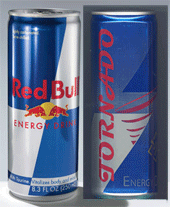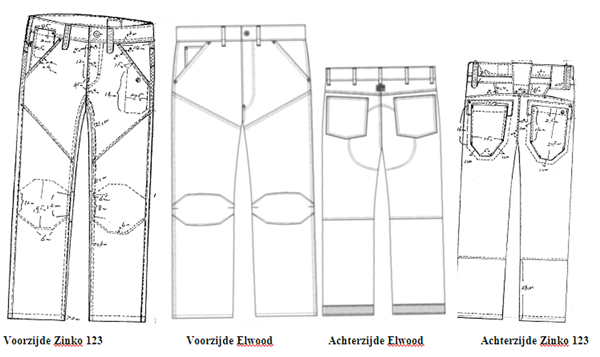Het achtergrondontwerp
 Rechtbank ’s-Gravenhage, 7 oktober 2009, HA ZA 07-1829, Red Bull GmbH tegen Frisdranken Industrie Winters (met dank aan Klos Morel Vos & Schaap)
Rechtbank ’s-Gravenhage, 7 oktober 2009, HA ZA 07-1829, Red Bull GmbH tegen Frisdranken Industrie Winters (met dank aan Klos Morel Vos & Schaap)
Merkenrecht. Exportmerk. Overeenstemmende kleurvlakken. Afvullen kwalificeert als gebruik als merk. “Het vullen van een vloeistofverpakking (een productiehandeling) waarop een merk is aangebracht, is aldus te kwalificeren als het aanbrengen van een merk op die vloeistof.” (Bellure)inbreuk sub b & sub c ('in het kielzog komen').
4.9. Winters vult in opdracht van een derde van die derde afkomstige blikjes af en levert deze gevuld weer bij die derde af, welke derde vervolgens de blikjes in het verkeer brengt (exporteert naar Tunesië in dit geval). In die constellatie is Winters weliswaar (derhalve) geen belanghebbende (…) bij een verkoop van waren waarin zij zelf wel verbonden partij is, maar staat op de betreffende blikjes wel vermeld dat Winters Producent is. (…)
4.10. Het ‘niet belanghebbende zijn’ bij de verkoop van de blikjes zelf of het al dan niet aanspraak kunnen maken op een (eigendoms)titel op de waar, is merkenrechtelijk onvoldoende in het licht van UDV/Brandtraders om te kunnen aannemen dat hier geen sprake is van gebruik als merk.
(…) 4.23. Het dominerende en onderscheidende bestanddeel (waaraan meer gewicht toekomt bij de overeenstemmingsvraag, nu die immers in het totaalbeeld meer opvalt) uit het Gemeenschapsmerk betreft de trapeziumvormige blauw/grijze kleurvlakken (…) Die elementen komen in gewijzigde vorm, maar herkenbaar terug in het achtergrondontwerp van het Tornado blikje, dat van dezelfde of vrijwel dezelfde tinten blauw/grijs gebruik maakt. (…) in de blikjes van Red Bull en Tornado dezelfde kleur rood wordt gebruikt voor de naam van de producten. Naar totaalindruk is bij het Tornado blikje zodoende sprake van een overeenstemmend teken ten opzichte van de ingeroepen merken van Red Bull.
(…) 4.28. Gelet op de onbetwiste marktleiderspositie van Red Bull in het energy drinks marktsegment en de dito bekendheid van haar ingeroepen merken, waarvan de onderscheidende en dominerende bestanddelen als hiervoor overwogen zijn overgenomen op het Tornado blikje, wordt aannemelijk geacht dat met het Tornado blikje is gepoogd in het kielzog te komen van marktleider Red Bull, waarmee ongerechtvaardigd voordeel is behaald. (…) ook de “sub c grondslag kan bij die stand van zaken in het onderhavige geval een merkinbreukverbod dragen."
Lees het vonnis hier of inmiddels ook hier ('schone' pdf Rb DH).
null
 Rechtbank Amsterdam, 19 augustus 2009, LJN: BJ7584, Costume National Distribution S.R.L. tegen Velvet Uomo B.V.
Rechtbank Amsterdam, 19 augustus 2009, LJN: BJ7584, Costume National Distribution S.R.L. tegen Velvet Uomo B.V. Vzr. Rechtbank ’s-Gravenhage, ex parte beschikking van 26 augustus 2009, KG RK 09-2267, Bose Corporation c.s. tegen Foka B.V.
Vzr. Rechtbank ’s-Gravenhage, ex parte beschikking van 26 augustus 2009, KG RK 09-2267, Bose Corporation c.s. tegen Foka B.V. Vzr. Rechtbank ’s-Gravenhage, ex parte beschikking van 2 september 2009, KG RK 09-2315, The Polo/Ralph Lauren Company tegen Metro Cash & Carry Nederland B.V.
Vzr. Rechtbank ’s-Gravenhage, ex parte beschikking van 2 september 2009, KG RK 09-2315, The Polo/Ralph Lauren Company tegen Metro Cash & Carry Nederland B.V. HvJ EG, 6 oktober 2009, zaak C-301/07, PAGO International GmbH tegen Tirolmilch registrierte Genossenschaft mbH (prejudiciële vragen Oberste Gerichtshof (Oostenrijk)
HvJ EG, 6 oktober 2009, zaak C-301/07, PAGO International GmbH tegen Tirolmilch registrierte Genossenschaft mbH (prejudiciële vragen Oberste Gerichtshof (Oostenrijk)
 Vzr. Rechtbank ’s-Gravenhage, 29 september 2009, KG ZA 09-1032, TNT N.V. & Logispring Investment Fund N.V. c.s. tegen Logispring Executives B.V. c.s.
Vzr. Rechtbank ’s-Gravenhage, 29 september 2009, KG ZA 09-1032, TNT N.V. & Logispring Investment Fund N.V. c.s. tegen Logispring Executives B.V. c.s. Vzr. Rechtbank Breda, 1 oktober 2009, KG ZA 09-510, Stichting Afzetbevordering Grootgroenproducten tegen Direct Select (met dank aan Rutger van Rompaey,
Vzr. Rechtbank Breda, 1 oktober 2009, KG ZA 09-510, Stichting Afzetbevordering Grootgroenproducten tegen Direct Select (met dank aan Rutger van Rompaey,  Rechtbank ’s-Gravenhage, 23 september 2009, HA ZA 08-1452, Euprax Perchtold & Partner Steuerberatersozietät (EPP) tegen B, tevens h.o.d.n. Euprax en Zobu B.V.
Rechtbank ’s-Gravenhage, 23 september 2009, HA ZA 08-1452, Euprax Perchtold & Partner Steuerberatersozietät (EPP) tegen B, tevens h.o.d.n. Euprax en Zobu B.V. Gerechtshof Amsterdam, 29 september 2009, zaaknr. 200.019.012/01 SKG, G-Star International B.V. tegen Bestseller Retail B.V. (met dank aan Leonie Kroon,
Gerechtshof Amsterdam, 29 september 2009, zaaknr. 200.019.012/01 SKG, G-Star International B.V. tegen Bestseller Retail B.V. (met dank aan Leonie Kroon, 




















































































